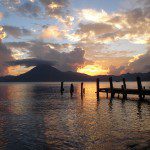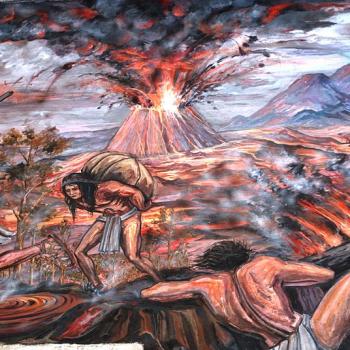
(Wikimedia Commons public domain image)
My stay in St. George over this long holiday weekend has been a nostalgic one, in some ways. Although she grew up here, my mother left for Los Angeles as soon as she graduated from high school. But I always had maternal relatives here, and we would visit them at least once or twice a year, often proceeding to the greater Salt Lake area, where other relatives lived. In such cases, St. George marked the overnight stop en route, and some of my earliest memories are of stopping in at motels along the main drag (there wasn’t very much city beyond it) in order to check out their rooms. My mother was quite particular, and it usually took two or three stops before we found a place to her satisfaction. By that point, I was generally a very tired little kid, and I kept hoping “Please, let this one be good enough so that I can go to bed!” But it was also something of an adventure. Where would we stay? What would it look like?
Those motels are all gone now, or (at a minimum) are transformed beyond (my) recognition. Dick’s Cafe and the Big Hand Cafe, landmarks of my early childhood, are gone. The city of St. George is vastly larger and much more sophisticated than when I first remember seeing it. Lots and lots of Utahns who had emigrated to California and the West Coast have now returned, for warmth and, for a time at least, lower housing prices. And a nearby temple. It has a multitude of restaurants, offering a wide variety of cuisine. (We ordered take-out from the Red Fort, a quite good Indian restaurant, the other night. To our distress when we arrived to pick our food up, it was absolutely packed, as crowded as any American restaurant we’ve ever seen, without the slightest hint of social distancing. If we die of COVID-19, my money is on the Red Fort as the place where we will have contracted it.)
As I grew up, my mother told me several times of a prophecy that she attributed to Brigham Young. In it, he predicted that the St. George Temple, which was out on or beyond the outskirts of town, would someday stand in the middle of a thriving city. I have no idea whether he really made such a prophecy — I keep meaning to check, but then forget — but, if so, it has certainly come true. In fact, remarkably, a second temple — slated to be the twentieth in Utah — is now under construction within the boundaries of the city of St. George, around some of the hills and out of sight of the original nineteenth-century temple.
Some of my mother’s family continued to live here in St. George, so, yesterday, my wife and I spent a part of the day visiting the graves of several of my relatives. My grandfather, who died a decade before I was born, is buried in the main city cemetery, which is located near the state university (!). So, too, is my grandmother. I’m not sure that I remember my grandmother; perhaps it’s just her photographs that I “recall.” Like my similarly-widowed paternal grandmother, she died when I was five. One of my earliest memories, though, for some reason, is being out in the sun on the lawn at Metcalfe Mortuary, on the occasion of her funeral. Nothing else from that occasion. Just that.
So we found the graves of my grandparents. We also visited the grave of my Uncle Jack and his first wife, Barbara. He was a favorite of mine. Sometimes, instead of going to a motel, we stayed with them when we came to St. George. She was a marvelous cook, but she died suddenly just short of her fiftieth birthday. It was a huge shock to all of us. Jack was a trucker for Milne Brothers, a company that I believe no longer exists. I remember his great sense of humor, his store of memorized narrative poems, and his intimidating ability with a pool cue. His last assignment was the route from St. George to Los Angeles, so he often stayed at my parents’ home. And another uncle, Ken, for whom my brother was named, is also buried in the St. George Cemetery, along my Aunt Eleanor, even though they made their home for much of my life in southern California. Of all of my uncles, he was the one that I knew the best and saw most often; he worked for the construction business that my father and one of my paternal uncles founded and owned. We also found the grave of my mother’s little brother Keith, who died in 1933 at just six months of age. I grew up hearing about him, but had never before known where he was buried. And we visited the graves of several cousins, all gone too young. I remember them vividly as teenagers. Many ended well. Some whom I remember as wild and anything but “churchy” when they were young were temple workers when they died, in St. George and elsewhere; their obituaries tell of how much they loved serving in the temple. One died suddenly, horribly, at the hand of another person.
Visiting their graves was an occasion for memories, for contemplation, for considering what lasts and what is most important when all else drops away. Good for the soul.
***
An article, this one by Robert F. Smith, has been newly posted today in Interpreter: A Journal of Latter-day Saint Faith and Scholarship:
“Poesy and Prosody in the Book of Mormon”
Abstract: Robert Smith makes the case that “poetic art in the Book of Mormon is highly developed” — you just need to have the eye to recognize it. Though many readers are aware of the stunning examples of chiasmus in the Book of Mormon, thanks to the pioneering work by John W. Welch, fewer are acquainted with the other important forms of parallelism that pervade the text, often placed strategically to highlight the importance of a particular passage. Smith also shows why apocalpytic texts, sometimes thought to originate at a later period, can be found, for example, in the first chapter of the Book of Mormon.
[Editor’s Note: Part of our book chapter reprint series, this article is reprinted here as a service to the LDS community. Original pagination and page numbers have necessarily changed, otherwise the reprint has the same content as the original.
See Robert F. Smith, “Poesy and Prosody in the Book of Mormon,” in “To Seek the Law of the Lord”: Essays in Honor of John W. Welch, ed. Paul Y. Hoskisson and Daniel C. Peterson (Orem, UT: The Interpreter Foundation, 2017), 429–67. Further information at https://interpreterfoundation.org/books/to-seek-the-law-of-the-lord-essays-in-honor-of-john-w-welch-2/.]
Also recently up on the website of the Interpreter Foundation:
Posted from St. George, Utah












